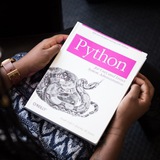Data Analysis with Python and PySpark (Jonathan Rioux).pdf
14.6 MB
Data Analysis with Python and PySpark PDF
👍4👏1
Which programming language should I use on interview?
Companies usually let you choose, in which case you should use your most comfortable language. If you know a bunch of languages, prefer one that lets you express more with fewer characters and fewer lines of code, like Python or Ruby. It keeps your whiteboard cleaner.
Try to stick with the same language for the whole interview, but sometimes you might want to switch languages for a question. E.g., processing a file line by line will be far easier in Python than in C++.
Sometimes, though, your interviewer will do this thing where they have a pet question that’s, for example, C-specific. If you list C on your resume, they’ll ask it.
So keep that in mind! If you’re not confident with a language, make that clear on your resume. Put your less-strong languages under a header like ‘Working Knowledge.’
Companies usually let you choose, in which case you should use your most comfortable language. If you know a bunch of languages, prefer one that lets you express more with fewer characters and fewer lines of code, like Python or Ruby. It keeps your whiteboard cleaner.
Try to stick with the same language for the whole interview, but sometimes you might want to switch languages for a question. E.g., processing a file line by line will be far easier in Python than in C++.
Sometimes, though, your interviewer will do this thing where they have a pet question that’s, for example, C-specific. If you list C on your resume, they’ll ask it.
So keep that in mind! If you’re not confident with a language, make that clear on your resume. Put your less-strong languages under a header like ‘Working Knowledge.’
👍12❤6
Robust_Python_Write_Clean_and_Maintainable_Code_Patrick_Viafore.pdf
7.2 MB
Robust Python: Write Clean and Maintainable Code PDF
👍7👏1
Best python github Repositories very helpful for beginners -
1. scikit-learn : https://github.com/scikit-learn
2. Flask : https://github.com/pallets/flask
3. Keras : https://github.com/keras-team/keras
4. Sentry : https://github.com/getsentry/sentry
5. Django : https://github.com/django/django
6. Ansible : https://github.com/ansible/ansible
7. Tornado : https://github.com/tornadoweb/tornado
1. scikit-learn : https://github.com/scikit-learn
2. Flask : https://github.com/pallets/flask
3. Keras : https://github.com/keras-team/keras
4. Sentry : https://github.com/getsentry/sentry
5. Django : https://github.com/django/django
6. Ansible : https://github.com/ansible/ansible
7. Tornado : https://github.com/tornadoweb/tornado
👍6
What are python namespaces?
👉A Python namespace ensures that object names in a program are unique and can be used without any conflict. Python implements these namespaces as dictionaries with ‘name as key’ mapped to its respective ‘object as value’.
Let’s explore some examples of namespaces:
👉Local Namespace consists of local names inside a function. It is temporarily created for a function call and gets cleared once the function returns.
👉Global Namespace consists of names from various imported modules/packages that are being used in the ongoing project. It is created once the package is imported into the script and survives till the execution of the script.
👉Built-in Namespace consists of built-in functions of core Python and dedicated built-in names for various types of exceptions.
👉A Python namespace ensures that object names in a program are unique and can be used without any conflict. Python implements these namespaces as dictionaries with ‘name as key’ mapped to its respective ‘object as value’.
Let’s explore some examples of namespaces:
👉Local Namespace consists of local names inside a function. It is temporarily created for a function call and gets cleared once the function returns.
👉Global Namespace consists of names from various imported modules/packages that are being used in the ongoing project. It is created once the package is imported into the script and survives till the execution of the script.
👉Built-in Namespace consists of built-in functions of core Python and dedicated built-in names for various types of exceptions.
👍8
Inheritance in Python with an example?
👉As Python follows an object-oriented programming paradigm, classes in Python have the ability to inherit the properties of another class. This process is known as inheritance. Inheritance provides the code reusability feature. The class that is being inherited is called a superclass or the parent class, and the class that inherits the superclass is called a derived or child class. The following types of inheritance are supported in Python:
👉Single inheritance: When a class inherits only one superclass
👉Multiple inheritance: When a class inherits multiple superclasses
👉Multilevel inheritance: When a class inherits a superclass, and then another class inherits this derived class forming a ‘parent, child, and grandchild’ class structure
👉Hierarchical inheritance: When one superclass is inherited by multiple derived classes
👉As Python follows an object-oriented programming paradigm, classes in Python have the ability to inherit the properties of another class. This process is known as inheritance. Inheritance provides the code reusability feature. The class that is being inherited is called a superclass or the parent class, and the class that inherits the superclass is called a derived or child class. The following types of inheritance are supported in Python:
👉Single inheritance: When a class inherits only one superclass
👉Multiple inheritance: When a class inherits multiple superclasses
👉Multilevel inheritance: When a class inherits a superclass, and then another class inherits this derived class forming a ‘parent, child, and grandchild’ class structure
👉Hierarchical inheritance: When one superclass is inherited by multiple derived classes
👍10
What are the common built-in data types in Python?
Python supports the below-mentioned built-in data types:
Immutable data types:
👉Number
👉String
👉Tuple
Mutable data types:
👉List
👉Dictionary
👉set
Python supports the below-mentioned built-in data types:
Immutable data types:
👉Number
👉String
👉Tuple
Mutable data types:
👉List
👉Dictionary
👉set
👍10🔥7❤1
